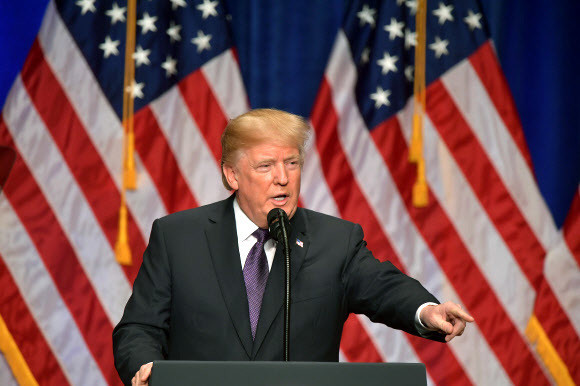 |
|
US President Donald Trump gestures during a speech about his administration’s new national security policy on Dec. 18. (AFP/Yonhap News)
|
US President reiterates that North Korean nuclear crisis “will be taken care of”
The administration US President Donald Trump published a new national security strategy report on Dec. 18, nearly eleven months after taking office. The report referred to North Korea and Iran as “rogue regimes,” but made no explicit reference to a preemptive strike or preventive war. “We remain ready to respond with overwhelming force to North Korean aggression and will improve options to compel denuclearization of the peninsula,” the White House said in the report. The message was read as signaling that the US would only use military force defensively in the event of a preemptive North Korean attack against the US or its allies, but would otherwise keep other options open, including sanctions and dialogue. The New York Times noted that the report did not mention the terms “preemptive strike” or “preventive war,” after White House National Security Advisor H. R. McMaster previously said either might be necessary if a diplomatic approach failed. A National Security Strategy report published during the George W. Bush administration in 2002 included justifications for preventive war and other preemptive military action, which served as a basis for invading Iraq six months later. Institute for National Security Strategy senior research fellow Cho Seong-ryoul said the report’s omission of references to military activity was due to the “low likelihood of it actually happening,” while Korea National Diplomatic Academy professor Kim Hyun-wook attributed it to “the determination that it would be better for a strategy report not to include concrete policies that change according to the situation.” But the report did signal more serious perceptions of the North Korean nuclear and missile threats than in a strategy report issued during the Barack Obama administration in 2015. The words “North Korea” appeared 17 times in the 68-page report – far more than the three instances in the 2015 version. Also, while the 2015 report only mentioned the possibility that North Korean provocations and threats could escalate into a serious crisis, the latest one claims that North Korea “seeks the capability to kill millions of Americans with nuclear weapons.” “The longer we ignore threats from countries [such as North Korea and Iran] determined to proliferate and develop weapons of mass destruction, the worse such threats become, and the fewer defensive options we have,” the report warns. The report also states the US is “deploying a layered missile defense system focused on North Korea and Iran to defend our homeland against missile attacks.” “This system will include the ability to defeat missile threats prior to launch,” it continues, in an apparent reference to the use of cyberattacks and other means to disable missiles. The report goes on to say the US “will cooperate on missile defense with Japan and South Korea to move toward an area defense capability.” Whether the reference to “area defense capability” is an allusion to a US-led missile defense system with South Korea and Japan will apparently only be known for use when Ballistic Missile Defense Review (BMDR) and Nuclear Posture Review (NPR) reports are released early next year. The report also says the US “will work with allies and partners to achieve complete, verifiable, and irreversible denuclearization on the Korean Peninsula and preserve the non-proliferation regime in Northeast Asia.” The message signals that in addition to pursuing denuclearization of North Korea, the US will also not recognize nuclear armament by South Korea or Japan. In releasing the report, Trump said that the North Korean nuclear crisis “will be taken care of.” “We have no choice,” he stressed. By Yi Yong-in, Washington correspondent and Noh Ji-won, staff reporter






